The Mayfly Dun
.........klinkhammer
Wikipedia: The Klinkhåmer, originally named LT Caddis (light tan), now officially named Klinkhåmer Special, was devised by a Dutch angler Hans van Klinken in the early 80's to imitate an emerging caddisfly to catch grayling and trout which feed from them as they float in the surface film. This pattern has proven to be an extremely effective fly.
This page is about the mayfly dun as a dry fly. Emergers and spinners will be part of an upcoming Spring Creek Flies chapter. What we here in the States refer to as our Classic Catskill Dryfly--not much changed from its earliest English chaulk stream forms--is still perhaps the most beautiful of all flies. The mayfly dun as a category, however, has undergone a long and steady evolution, particularly so in cold water streams and rivers west of New England.
Little Marryatt
The Little Marryatt--designed by George Selwyn Marryatt, who died in 1896--was not the first dry fly but it was perhaps the first classic that many of us still fish with today. The Little Marryatt is also a fly most definitely meant to imitate the freshly hatched subimago mayfly, or mayfly dun. This is the classic stuff of English chaulk stream dry fly fishing.
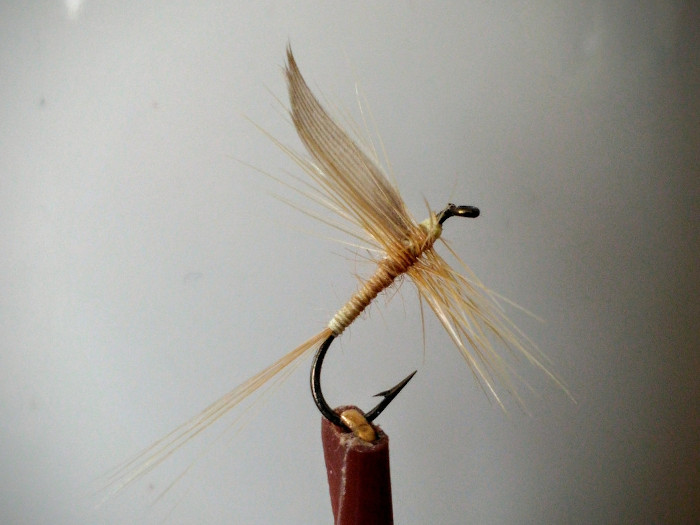
Quill Gordon
On our side of the Atlantic the earliest notable North American dry fly mayfly is probably Theodore Gordon's stunningly beautiful Quill Gordon I . Despite the Quill Gordon's widely recognized importance Gordon himself had surprisingly little to say about it. In the roughly 560 pages of his various letters and writings Gordon mentions the Quill Gordon only 8 times. In a letter to G.E.M. Skues, the longest of those 8 sentences reads as follows:
...I tied a few Quill G. on No. 1 hooks. I like to have this fly with bodies (quill) and hackles of several shades and one with quill tinged with yellow.
The Quill Gordon is indeed one of our greatest flies, tied with mostly local materials: dun hackle, wood duck wings and stripped peacock quill quill body. But it's hard to say much more when even its original designer has so little to say, other than it can be tied in a useful variety of shades. Selwyn Marriatt's Little Marryatt is similar: a beautiful dressing tied with a simple combination of readily available materials that can be shaded from light to dark, thereby filling a wide variety of roles. Perhaps that's what is so great about both those flies. With a little tweaking they can be almost anything. And still beautiful too.
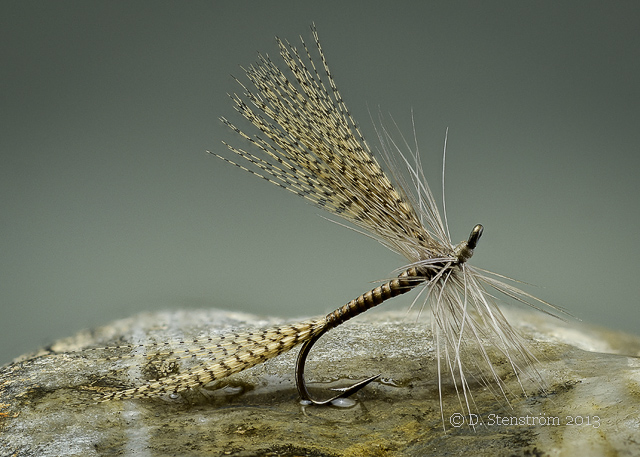
Classic Catskill
Theodore Gordon's work evolved through the 1930s 1940s and even 1950s to become what is now what many refer to as the Classic Catskill dry fly, as exhibited by the work of Art Flick, Walt and Mary Dette and others. This one, tied by Tom Littleton, illustrates placing the hackle and wing midway between the eye and the point of the hook, which gives the fly a graceful overall balance.
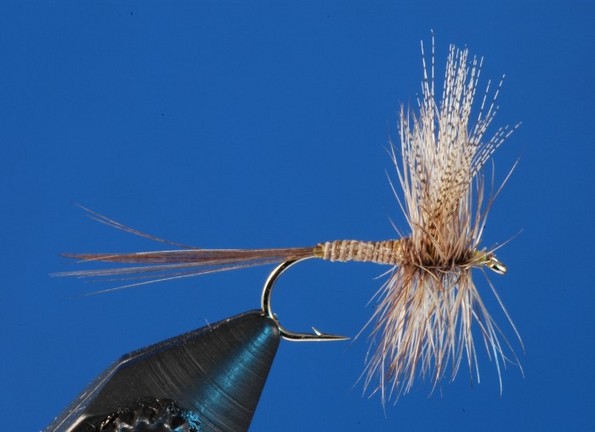
Clipped Hackle
Tiers who want the Classic Catskill model to perch closer to the water's surface--perhaps more like a real mayfly dun--sometimes clip the underside of the hackles. This is a George Kelly Pale Morning Dun. At 85 or so in 2022 George is force of nature. George is still spry and strong. George is one of the best and most respected birders in the State. Many of his birding friends know he also has something to do with fishing but they're not sure just what. George is the Dean of all Montana fishing guides right now. He's a hell of a fly tier too.
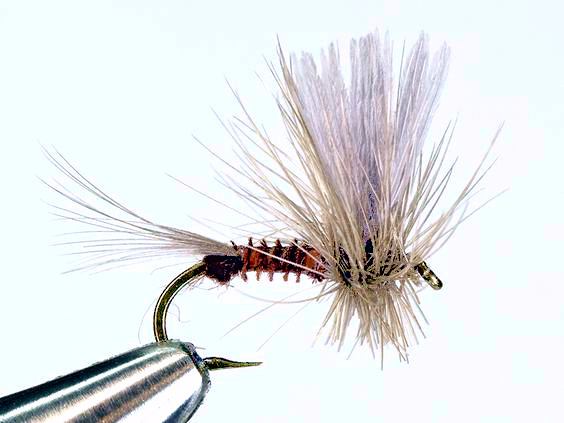
Perfect Dun
Datus Proper was a interesting guy who grew up in Yellowstone Park where his father was a Ranger. With the nelp of a scholarship Datus got an East Coast Brahmin education at the Phillips Excetere Academy and later went on to long career in the State Department where Datus distinguished himself I admirably well.Datus retired to Thompson Spring Creek in the Gallatin Valley where he worked at fishing writing and fly tying. I met Datus a year or or two before his untimely passing when he and his buddy, a doctor from Belgrade MT, asked me for permission to hunt pheasants on piece of land I briefly owned at the North end of the Gallatin valley. Datus invited me to come join him on Thompson Spring Creek, in his back yard. I never called back. I'm looking down with my hands clasped on my temples--shaking head as I think of it. Datus had narcolepsy and fell asleep at a moment's notice. He apparently drowned in Hyalite Creek when he suddenly fell asleep, fell over and drowned in six inches of water. He left us with one very good book: What the Trout Said. Datus's primary fly was his Perfect Dun, which was similar to a clipped-on-bottom dun, like George Kelly's fly above. But Datus didn't clip the hackle, he spread it apart sideways on bottom, with a relatively long front to back, slightly dubbing-fattened figure eight thread wrap underneath, before whip finshing.
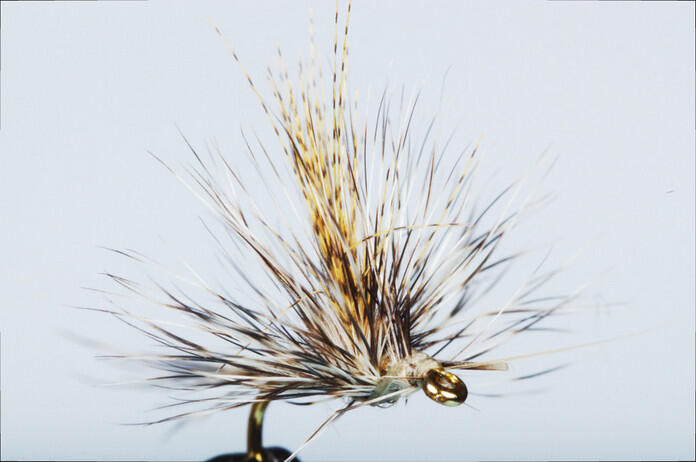
Parachute Dry Flies
The history of the parachute dry fly seems to start in the early 1930s I . Today's Adams Parachute might be the West's most popular not Royal Wulff dry fly. When I guided for George Anderson back in the early 1990s I didn't fully appreciate how good this fly was until Todd Wester came on board and started working at the Yellowstone Angler. I was 40 something and Todd was 20 something back then. Todd quickly shot up the ranks and became one of the store's most sought after guides. Todd is a school principal now. Back then Tood used the Parachute Adams a lot. Todd didn't use this fly on the Spring Creeks much. The Parachute Adams was a Yellowstone River fly for him. All through the Summer months and well into Fall. It is for me now too.
There are debates about who first invented the parachute dry fly. Was it a Scottish woman named Helen Todd or was it William Brush of Detroit Michigan? Does it matter? The Parachute is a great fly. Sparsely-tied biot-body parachutes with a slightly olive/yellow tint work well for PMD hatches too. They do tend to push the body of the fly down into the surface tension rather than riding on top.
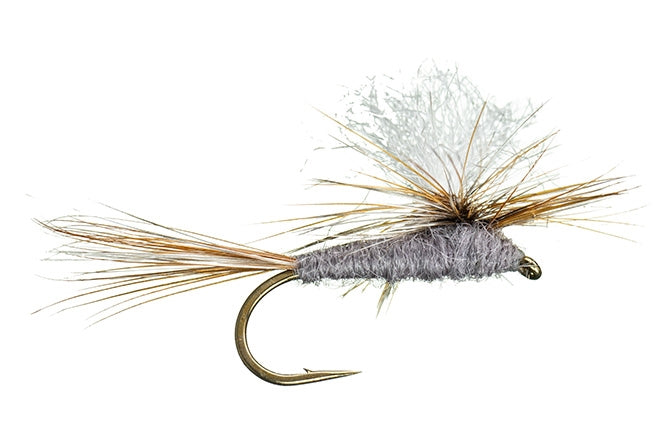
Swisher Richards
In the early 1970s Pennsylvanian Carl Richards and Michigan born fly designer Doug Swisher wrote about No-hackle duns, Paraduns, Comparaduns, Cripples, Emergers and v-hackle flies, all of which moved the high profile of the traditional at-right-angles-to-the-shank rooster hackle dry fly flatter and closer to the surface film--perhaps more like the profile of a real mayfly dun. Swisher and Richards talked a lot about "selectivity," indeed that was the name of their seminal book: Selective Trout ". In this section I want to duck below the trout-feeding-theory-radar in order to visually list and only briefly discuss the shapes of the major mayfly imitations that have emerged in addition to the traditional Halford/Marryat/Catskill dry fly mayfly. There are a lot of flies. It's been a fun ride.
No-Hackle
Fran Betters may have invented the no-hackle idea quite a while ago (1930s? 1940s?). Swisher/Richards further popularized this pattern in their book Selective Trout. Rene Harrop in Last Chance Idaho popularized this fly out West where it is now a Henry's Fork and Paradise Valley spring creeks favorite. No-hackle dries are a bit hard to cast. They sometimes make an audible fluttering sound as you false cast them. Once you've caught a few fish the wings lose their sculpted shape and become more like soft miniature paint brushes than finely sculpted wind scoops. Paint brush wingsare easier to cast and at that point I find they catch fish just as well. I They are very good flies--one of the best spring creek patterns we have. I like them best after catching a few fish first.
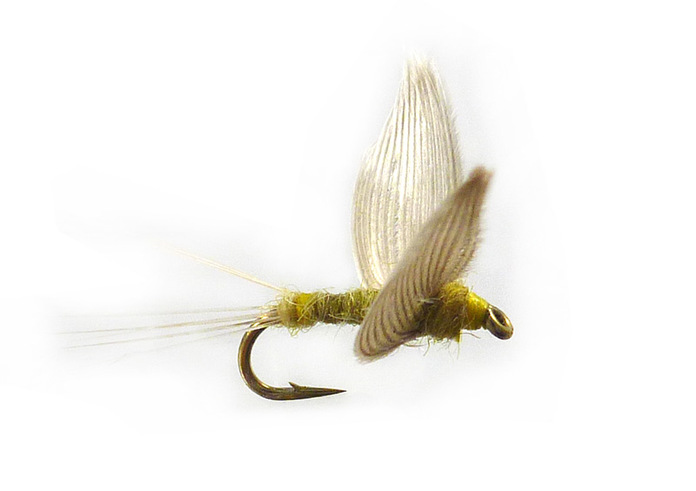
Compara Dun
The Swisher/Richards Compara Dun had no rooster hackle wound around the snank but it did gain considerable flotation from its side-splayed deer hair wing. The Comparadun is a better floater than its no-hackle cousin.
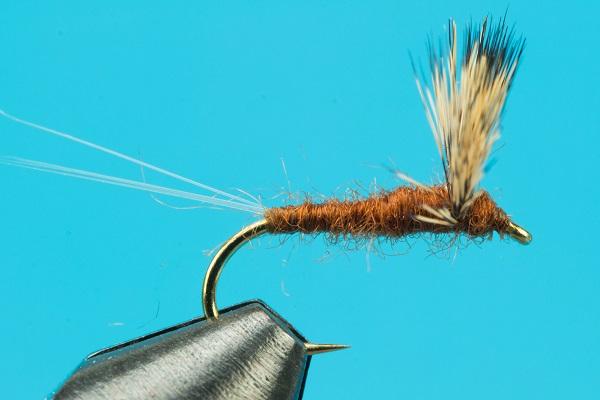
Sparkle Dun
The Compara Dun was an important new mayfly weapon for Match the Hatch enthusiasts but it wasn't in any way a fast water floater. Craig Mathews added a Zelon tail, which looks like a trailing nymphal shuck and also made it a more tenatiously floating fly. Craig Christened his fly the Sparkle Dun. What a good fly. This is one of the very best.
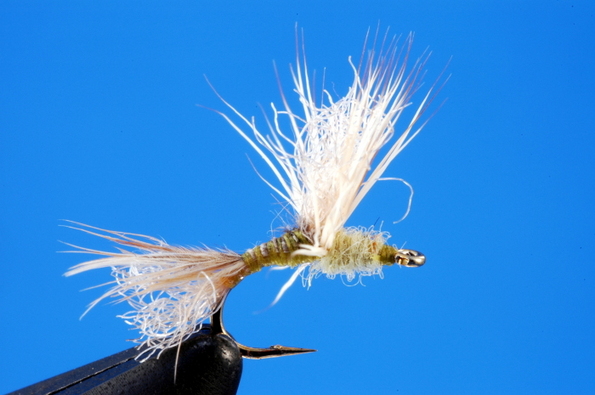
The following mayfly dry fly probably isn't John Betts's best work. It is a fly one of John's Denver area neighbors gave me back in the mid-1980s. This fly's enhanced flotation comes from a horizontal bowtie tuft of Zelon underneath the thorax. How John accomplished this bottom-mounted hackle tuft isn't clear and I did not want to cut the fly apart. I ran with this idea and conjured the now widely world famous (not) Right Hackle idea, as shown a bit further down.
Betts Baetis
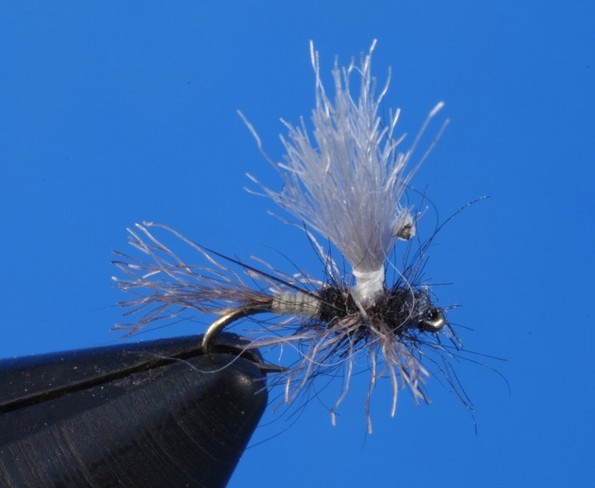
The mayfly hatches that matter most in Southwest Montana are Spring and Fall Baetis, early Summer Pale Morning Duns and perhaps the large grizzly/gray Callibaetis too, on the various lakes and reservoirs. We get other mayflies too but not in great numbers and not for long periods of time. From March through April you can find a few Marchbrowns here and there, enough to make the fish look up and rise if you offer one. But I've never seen enough Marchbrowns at once to make fish dimple all around me. Every once in a while on a lucky day in July, especially if a sunny day suddenly gets cloudy and threatens to storm you can run into a real hatch of big Green Drakes. Big by our standards anyway. Fun as they are those hatches are rare. They are much more reliable in far-away places like Idaho, on the Henry's Fork and on Silvercreek.
During Baetis hatches (aka the Blue Winged Olives) I fish wet flies more often than dry flies but I do fish both. BWOs are small critters. Tiny Parachutes, Emergers and Sparkle Duns are available in the fly shops but I tie my own and those patterns are tricky and hard for my aging eyes to tie in tiny Blue Winged Olive sizes. Wet flies are easy. That's one of the reasons I fish them so often. For BWO wet flies I don't even bother with hen hackle. I make a dubbed or biot body and then lash on a small tuft of Tan-brown Senyo Laser Dub. I don't even have a name for that wet fly but it is a goto pattern for me. At BWO time.
For easy to tie BWO dry flies I have a pattern I call the Ducktail, made from duck flank and Senyo Laser Dub. It's a lot easier than a parachute that small. Even a bit easier than a Sparkle Dun. The Sparkle Dun is an all time great fly and not hard at all in PMD sizes, but I do find it a bit tricky for BWOs. The Ducktail is an extended body fly tied on a short shank hook, where the tail is not the tail it is the abdomen. The wing is a bit more duck flank or, sometimes, a tuft of Senyo Laser Dub pulled up either side of the shank. The hackle is splayed-out loosely basted bow tie of Snow Shoe rabbit or Zelon, glued on as a final step with UV glue or CA glue. It's fast and easy. Floats like a champ. Lands upright. Dries off quickly. This for me is the quickest and easiest dry fly to tie in the smallest sizes. But it is no compromise. This is a good fly: easy to make, easy to cast, lands softly, lands upright, dries off quickly and catches fish. There are a lot of dry flies I can think of whose attribute checklist compares weakly. or Pale Morning Duns (aka PMDs) I often tie the same Ducktail pattern a bit larger, with a more olive coloring.
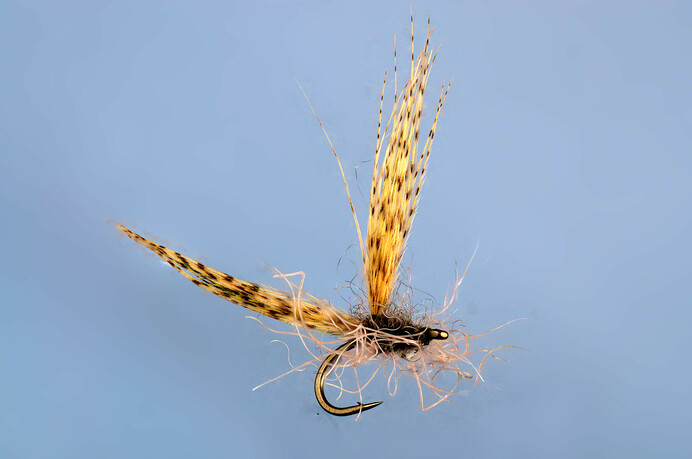
Paragon
Mostly for the fun of the tying I have another more complex pattern I call the Paragon. The Paragon is a bit of a paradigm shift. I tie most of it on a long thin #20 beading needle, wings and all, and slide that off the needle before mounting it on a short shank hook. Then I add a parachute hackle or a bow tie Right Hackle below the wing. If it's a parachute I wind that between the loosely-mounted modular body and the shank. That puts the parachute on the bottom of the thorax rather than on top. I like tying them and looking at them. I cannot honestly say they attract strikes any better. They do land upright every time, float well, land gently and dry off quickly. It is a good-looking fly and it is a never-been-done before technique. That must be worth something. A smile at the vise anyway. I have caught too many fish to count on these nifty little flies.
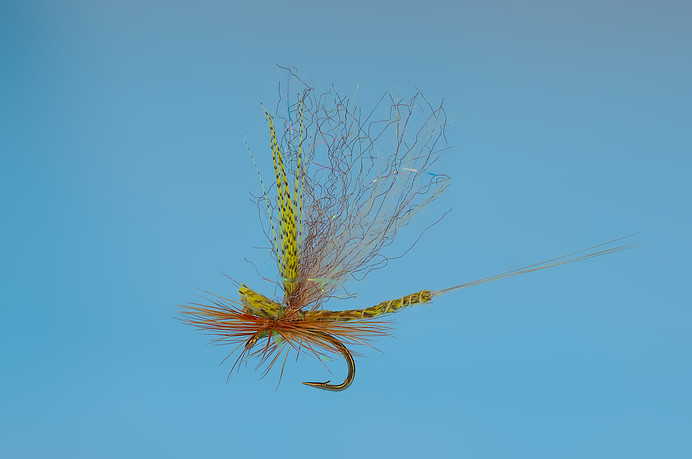
Notes:
I The index for The Complete Fly Fisherman (Gordon's notes and letters) lists Quill Gordon on 8 separate pages, but Gordon in most cases has little to say about his most notable fly. In nearly every one of those 8 listed pages Gordon says little at all about the Quill Gordon other than mentioning its name. In one case he tells the story of fishing with an unually darkly-hackled Quill Gordon, but little else. In the same index Gordon's favorite streamer, his own Bumblepubby, is mentioned on twelve separate pages, and in many of those cases he has quite a bit to say about the Bumblepuppy. I mention this only because--I find it interesting.